Understanding the Meaning of the Heart Symbol: A Guide to Its Interpretations
The heart symbol, historically and culturally, embodies much more than romantic love. It has ancient origins, symbolizing the soul, intellect, and moral virtues in civilizations like Greece, Egypt, and China.
Religiously, it represents compassion, faith, and spiritual depth across Christianity, Islam, Hinduism, and Buddhism. In medieval and Renaissance art, it conveyed virtues such as loyalty, courage, and divine sacrifice.
Modern digital communication employs the heart symbol to express emotions universally. Colors like red, pink, and yellow denote various kinds of love and friendship.
To appreciate its full depth and cross-cultural meanings, further exploration reveals additional layers.
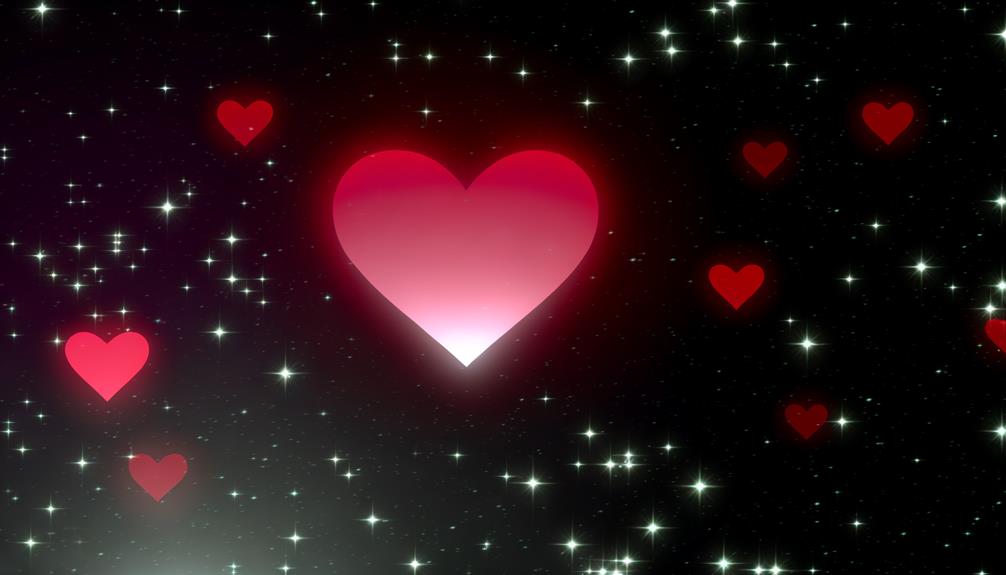
Key Takeaways
- The heart symbol often represents love, affection, and emotional bonds.
- In digital communication, it conveys emotions like love, friendship, and joy.
- Across cultures, the heart symbol embodies spirituality, life, and gratitude.
- In religious contexts, it signifies faith, compassion, and divine love.
- Historically, the heart symbol has denoted virtues such as loyalty, courage, and piety.
Ancient Origins
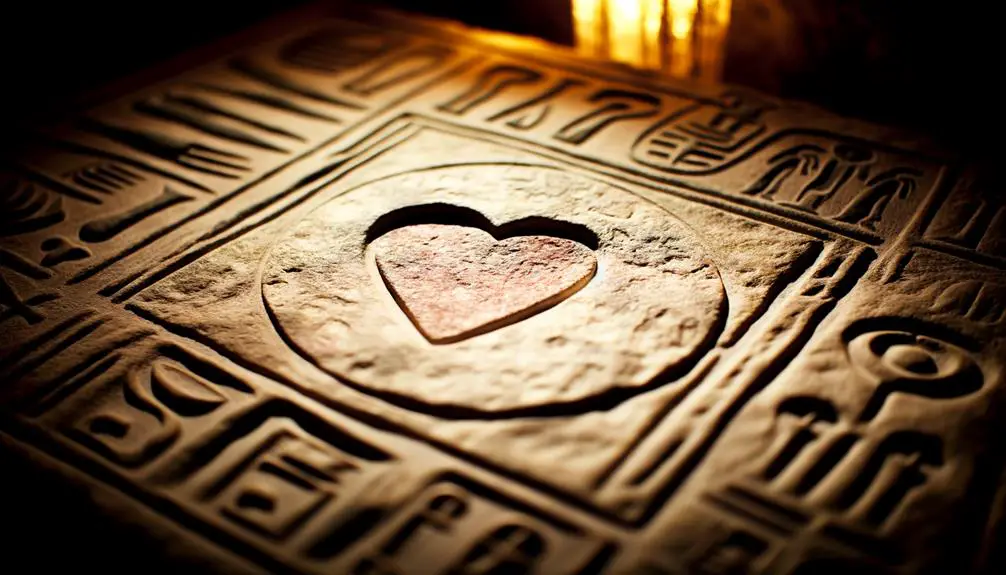
The heart symbol, widely recognized today as an emblem of love and affection, finds its ancient origins in diverse cultures where it represented a range of spiritual and philosophical concepts.
In ancient Greece, the heart was linked to the soul and intellect, symbolizing the core of human life and emotion. Similarly, in Egyptian hieroglyphs, the heart was central to the concept of morality and the afterlife.
In contrast, the ancient Chinese culture associated the heart with the center of human thought and consciousness.
Such cross-cultural comparisons reveal that while the heart symbol's modern association with romantic love is relatively recent, its historical significance as a representation of central human experiences and values is profound and multifaceted.
Religious Significance
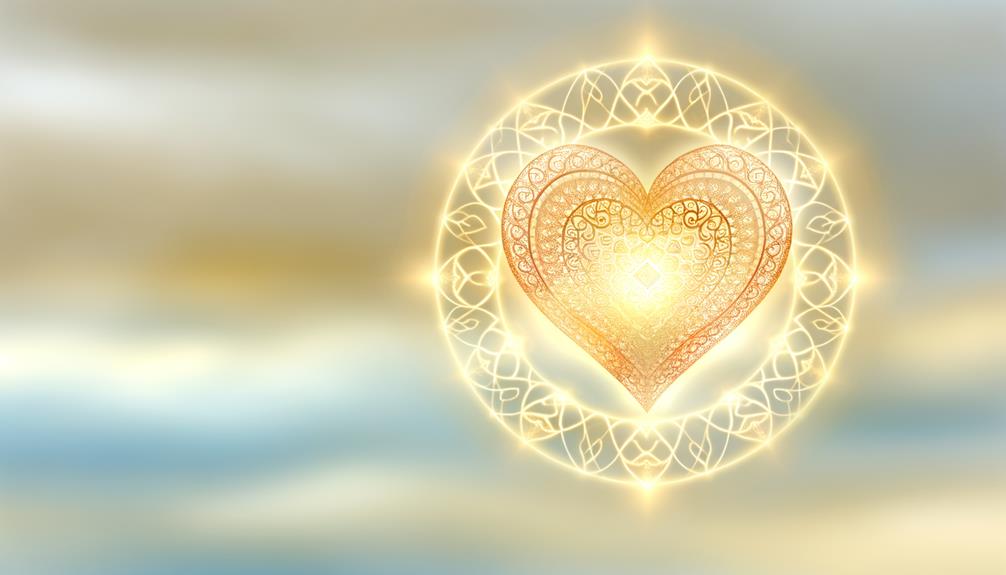
In various religious traditions, the heart symbol often embodies divine love, spiritual wisdom, and the moral compass guiding human behavior. This symbol carries profound significance across cultures and faiths:
- Christianity: The Sacred Heart of Jesus represents God's boundless love and compassion for humanity.
- Islam: The heart is seen as the seat of faith, with purity of heart being essential to spiritual growth.
- Hinduism: The heart chakra, or Anahata, symbolizes harmony, balance, and the integration of worldly and spiritual concerns.
- Buddhism: The heart is associated with the cultivation of compassion (Karuna) and loving-kindness (Metta).
Through these interpretations, the heart symbol transcends cultural boundaries, illustrating a universal quest for spiritual meaning and moral integrity.
Medieval Interpretations
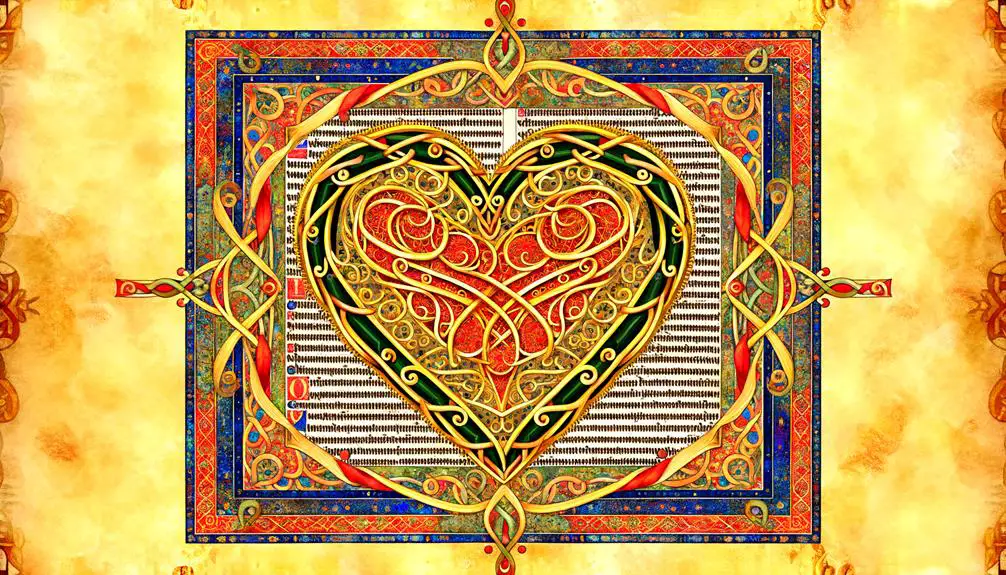
During the medieval period, the heart symbol frequently appeared in heraldry, representing love, loyalty, and courage among knights and noble families.
Additionally, its religious connotations were significant, often symbolizing the Sacred Heart of Jesus in Christian iconography, embodying divine love and compassion.
This dual usage underscores the heart's multifaceted role in both secular and spiritual spheres.
Symbolism in Heraldry
Frequently, medieval heraldry imbued the heart symbol with significant significance, often representing concepts of love, courage, and piety within the intricate tapestry of chivalric iconography. This emblem transcended mere decoration, symbolizing deeper virtues attributed to knights and noble families.
Key interpretations included:
- Love: The heart symbolized romantic and familial affection, often depicted in shields and crests.
- Courage: It embodied the bravery and valor expected of knights, serving as a reminder of their duty.
- Piety: The heart reflected devoutness and spiritual dedication, integral to medieval life.
- Loyalty: It represented steadfastness and faithfulness, pivotal traits in feudal allegiances.
These interpretations varied across cultures, but consistently highlighted the heart as a central motif in medieval heraldic tradition.
Religious Connotations
Medieval interpretations of the heart symbol frequently associated it with the divine love and compassion of Christ, serving as a profound representation of spiritual devotion and religious fervor in Christian iconography. This emblematic heart, often depicted as the Sacred Heart of Jesus, encapsulated the essence of Christ's sacrificial love and boundless mercy.
In a broader cross-cultural context, similar heart symbols in medieval Islamic and Jewish art signified divine love and human piety, though expressed through different theological frameworks. These religious connotations underscore the heart's role as a universal emblem of spiritual and emotional depth, transcending cultural boundaries while adapting to specific religious narratives.
Consequently, the heart symbol in medieval times was a potent icon of faith and divine connection.
Renaissance Art
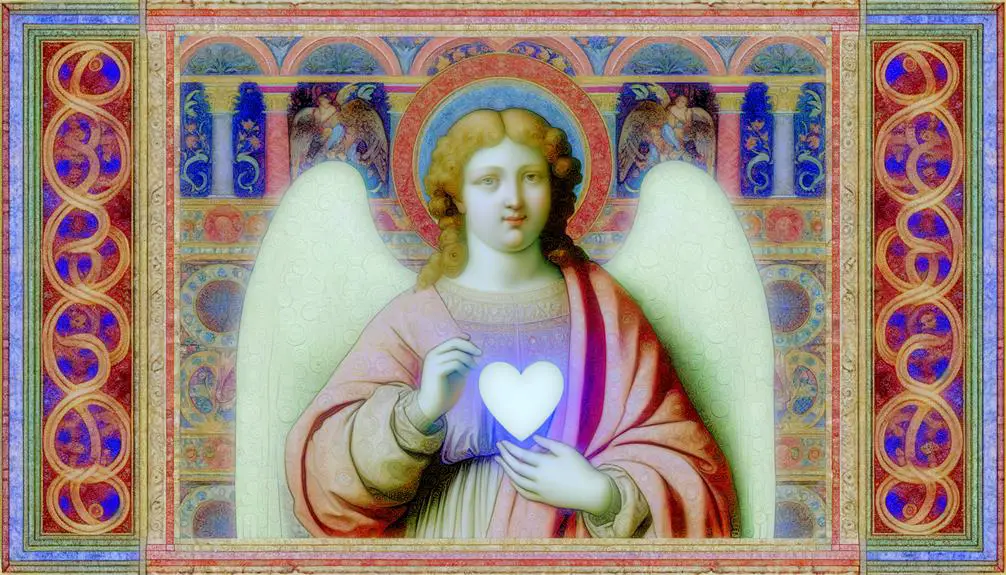
The heart symbol in Renaissance art often carried intricate layers of meaning, serving as both a representation of romantic and divine love, and reflecting the period's fascination with humanism and classical antiquity. Artists of this era utilized the heart to convey themes such as:
- Humanism: Emphasizing the human experience and individual emotion.
- Classical Antiquity: Drawing inspiration from Greco-Roman symbolism, where the heart was seen as the seat of the soul.
- Religious Symbolism: Integrating Christian motifs, depicting the heart as a symbol of Christ's sacrifice and divine love.
- Allegorical Interpretations: Using the heart in allegories to reflect virtues, vices, and moral lessons.
These interpretations reveal a cross-cultural dialogue, where the heart symbol transcended its physical representation to embody profound philosophical and spiritual ideas.
Romantic Love
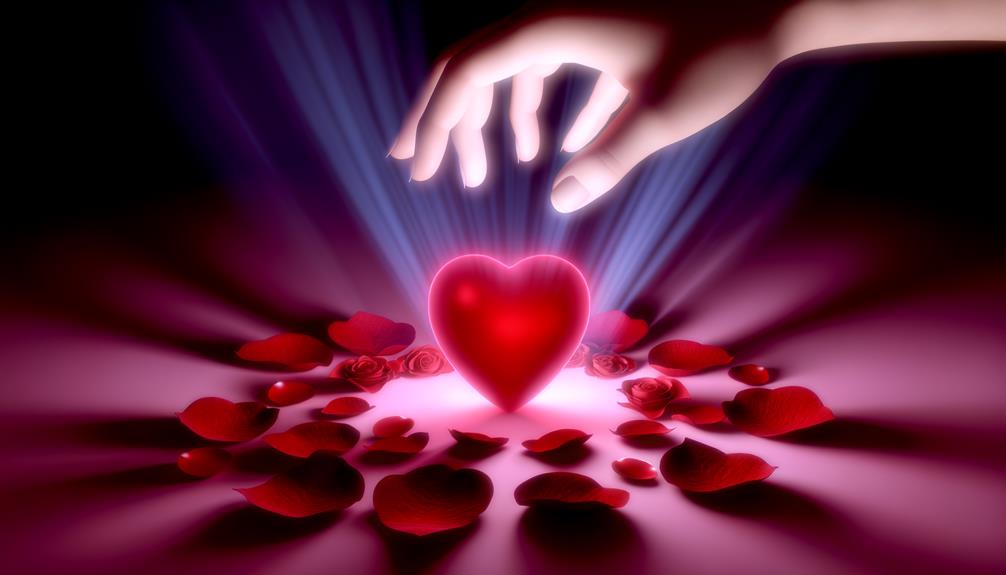
In the context of romantic love, the heart symbol universally signifies an expression of affection and an intimate emotional connection between individuals.
This symbol transcends cultural boundaries, appearing in various forms from the Valentine's Day cards in Western societies to the intricate designs in East Asian art.
Such widespread adoption underscores the heart's role as a powerful, cross-cultural emblem of love and emotional bonds.
Expression of Affection
Across various cultures, the heart symbol has long been revered as a potent emblem of romantic love, encapsulating deep emotional connections and the desire for intimate relationships. This symbol's power lies in its ability to convey affection succinctly and universally.
Analyzing its usage reveals:
- Western Culture: Often associated with Valentine's Day, representing romantic gestures like cards and chocolates.
- East Asian Contexts: Employed in digital communication, such as emoji, to express endearment and fondness.
- Middle Eastern Traditions: Symbolizes profound love, frequently found in poetry and art to evoke passionate emotions.
- African Symbolism: Utilized in traditional jewelry and textiles to signify marital bonds and family love.
Each culture adapts the heart symbol to articulate affection, underscoring its universal expressive power.
Emotional Connection
Romantic love, often symbolized by the heart, encapsulates a profound emotional connection that transcends cultural boundaries, inviting a deeper exploration of its significance in various traditions.
In Western cultures, the heart is synonymous with passion and deep affection, often highlighted in literature and art.
Conversely, in Eastern traditions, such as in India, the heart chakra (Anahata) represents not just romantic love but also compassion and emotional balance.
The heart symbol hence serves as a universal emblem, bridging diverse cultural understandings of love. This cross-cultural resonance underscores the heart's role in expressing intimate bonds, from the passionate intensity of Romeo and Juliet to the enduring devotion celebrated in ancient Chinese folklore.
Understanding these interpretations enriches our appreciation of the heart symbol's multifaceted meaning.
Modern Popularity
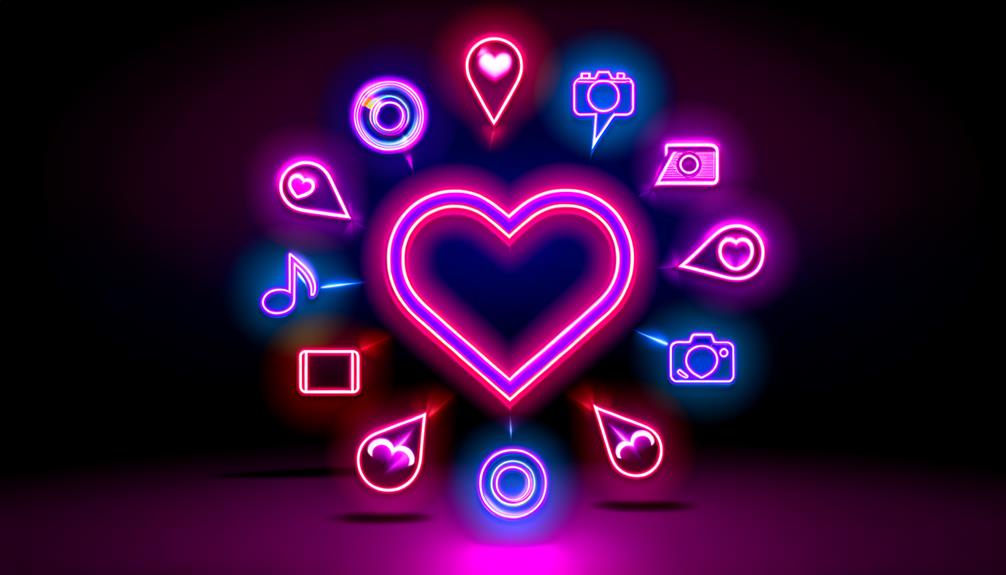
The heart symbol has surged in modern popularity, prominently featured in digital communication, fashion, and global marketing as a universal emblem of emotion and connection. This rise can be attributed to several factors:
- Digital Adaptation: Emoticons and emojis have transformed the heart symbol into a staple of online expression.
- Fashion Trends: Designers incorporate heart motifs to convey sentiments of love, compassion, and individuality.
- Global Marketing: Brands utilize the heart symbol to foster a sense of trust and emotional engagement with consumers.
- Cross-Cultural Acceptance: Different cultures have embraced the heart symbol, often integrating it with local traditions and meanings.
These elements illustrate the heart symbol's adaptability and enduring relevance as a multifaceted icon in contemporary society.
Digital Communication

In the world of digital communication, the heart symbol has become an indispensable tool for conveying a spectrum of emotions, from affection and gratitude to solidarity and empathy. This versatile icon transcends textual limitations, offering a universal shorthand for complex emotional states. Its use varies across platforms and contexts, reflecting nuanced interpretations depending on the medium.
| Platform | Context | Common Interpretation |
|---|---|---|
| Social Media | Likes | Affection, approval |
| Messaging | Conversations | Love, care, concern |
| Sign-offs | Warmth, friendliness |
The heart symbol's effectiveness lies in its ability to bridge gaps in communication. As users navigate diverse digital landscapes, the heart remains a potent emblem of human connection, highlighting its significance in fostering interpersonal relationships globally.
Cultural Variations
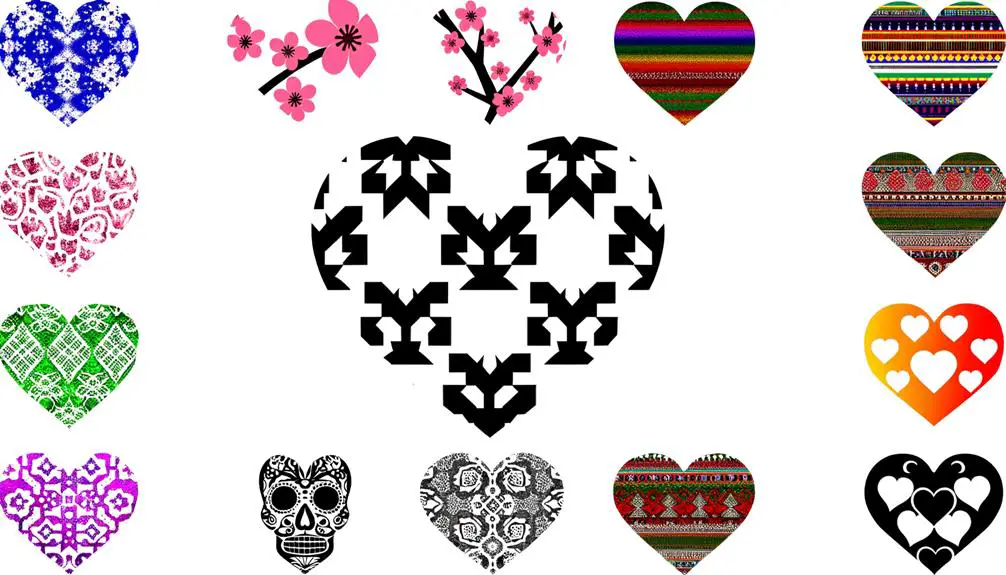
Across different cultures, the heart symbol's meaning can vary greatly, reflecting diverse traditions, beliefs, and social norms. This simple yet powerful symbol carries nuanced interpretations worldwide:
- Western Cultures: Often associated with love, romance, and affection, the heart symbol is prominently featured in holidays like Valentine's Day.
- Eastern Cultures: In countries like Japan, the heart can symbolize different emotions, including friendship and gratitude, often depicted in various artistic forms.
- Indigenous Cultures: Some indigenous groups may use heart motifs in their art to represent life, essentiality, and spiritual essence.
- Religious Contexts: In Christianity, the Sacred Heart represents Jesus Christ's divine love for humanity, symbolizing compassion and mercy.
Understanding these variations underscores the heart symbol's rich, multifaceted nature across cultural landscapes.
Symbolic Colors
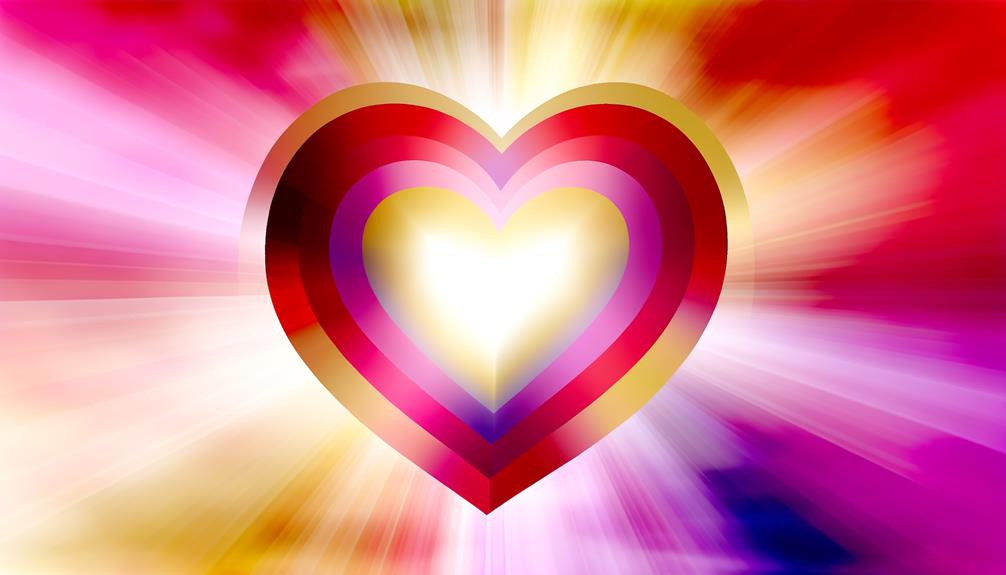
While the heart symbol itself is universally recognized, its associated colors can convey distinct meanings and emotions across different cultures. In Western contexts, a red heart typically signifies romantic love and passion, while a pink heart often represents affection and gratitude.
Contrastingly, a yellow heart can evoke feelings of friendship and joy. In Eastern traditions, colors hold different connotations; for instance, a white heart might symbolize purity and mourning in some Asian cultures. Meanwhile, a black heart can denote sorrow or dark humor universally.
Green hearts, less common, can signify nature and harmony in various cultures. These color variations underscore the heart symbol's nuanced role in expressing diverse human emotions, shaped by cultural perceptions and traditions.
Conclusion
The heart symbol, a timeless emblem, weaves through history like a crimson thread. Emerging from ancient origins, it pulses with religious fervor, medieval mysticism, and Renaissance artistry.
Its transformation into a beacon of romantic love illustrates its dynamic nature. In modernity, it thrives in digital communication and exhibits diverse cultural interpretations.
Each hue of the heart's palette—from passionate red to serene blue—paints a vivid tableau of human emotion and universal connection.






